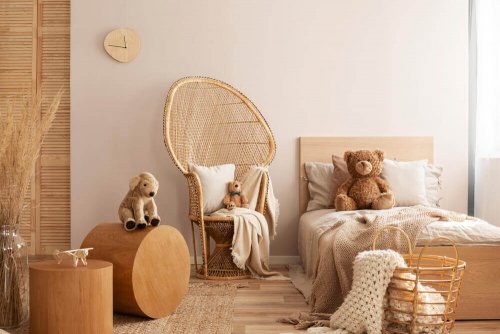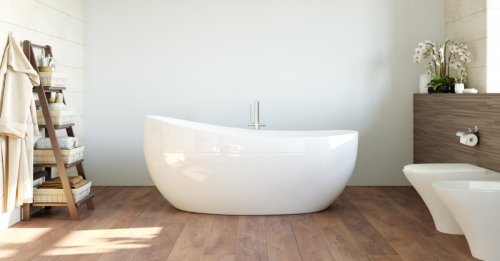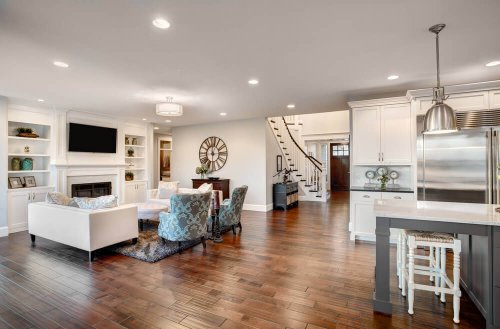Choosing the Right Type of Wood for Your Floors

To choose the right type of wood for your floors, you’re going to need to keep various things in mind. On the one hand, you have to consider both the conditions it’ll have to endure as well as the number of people walking on it. For example, if you’re going to lay wooden floors in a high-traffic area of the home, you’re going to need a more durable type of wood.
On the other hand, however, it’s also important that you consider the aesthetic effects you want your floors to have. Do you want them to blend perfectly with the rest of the home or do you want them to make a statement?
Now, keep in mind that the hardness of the wood, the tone, and the pattern of the grains are the main factors that you must take into account to opt for the most suitable type of wood for your floors.
Decisive factors when choosing the wood for your floors

Soft and noble
According to its hardness, wood is divided into soft (coniferous) and noble (leafy). Let’s check out the main characteristics of each of them.
First off, soft types of wood have a lower density. This makes them more vulnerable to marks that, for example, heavy furniture or even high-heeled shoes may leave. Pine, alder, and fir are the most popular.
Secondly, noble woods are less flexible. They are durable but are more expensive. The most common are jatoba and sucupira.
Tones and patterns

Another decisive factor in choosing the right wood for your floors is the color and pattern of the grain. You can choose between light (maple and beech), reddish (cherry), and dark (Iroco and jatoba).
As for the pattern, each species has a characteristic grain. For example, walnut has a wavy grain, ash is straight, and oak is irregular.
Growth rings are also more visible in those types of wood that grow in temperate zones. On the contrary, some tropical woods lack them.
Aging
There’s something you must be aware of, and it’s the fact that not all woods age the same way. For example, birch, oak, and beech turn yellow over time, whereas cherry, jatoba, and Merbau get darker and redder.
Also, there’s iroko and teak, two kinds of wood highly valued in interior design. While iroko takes on a dark brown hue, teak tends to blend into mid-tones.
Choosing the right type of wood for your floors

Woods from temperate climates
These can be quite different in color. Additionally, they tend to acquire a very beautiful patina over time. Beech, ash, oak, and maple are the types of wood most people like to use.
Furthermore, when it comes to light-colored woods, you have birch, which isn’t very resistant. Also, you can find ash, which has a rough texture, pine, which has a light effect, and fir, which has many knots.
Also in light tones, but more resistant and durable, is beech wood, which is widely used in high traffic areas. Oak could also be a good option but keep in mind that it has darker tones.
Tropical woods
These come from tropical areas of America, Africa, and Asia. Moreover, one of their main characteristics is that they present a rich range of shades, which makes them highly sought after in floor decoration.
Some of the most resistant types of woods are among them. For example, Merbau, which is widely used in outdoors, bathrooms, and kitchens. However, they tend to darken over time, except for sucupira, which turns reddish.
Ebony, mahogany, teak, and iroko are the most common. Although they’re quite pricey, they look great on floors.
There are other cheaper, lesser-known tropical woods. For example, planchonia, taun, kamarere, and turupay. These are very resistant and are sometimes a good alternative to other more expensive wood species.
Places where wooden floors work best

Room style
Light-colored woods have a timeless air and look great in contemporary settings. For classic settings, we recommend opting for dark-toned woods, such as oak and walnut.
Furthermore, in rustic settings, it’d be a good idea to opt for untreated woods as they’ll give your floors a natural touch.
Additionally, tropical woods look great in ethnic and colonial environments because they give great warmth to the whole space. They’ve also been making an appearance in avant-garde environments.
Of course, in recent years, the uncontrolled felling of trees has damaged several tropical species. As a consequence of this, some of them are currently in danger of extinction. Be environmentally aware!
To choose the right type of wood for your floors, you’re going to need to keep various things in mind. On the one hand, you have to consider both the conditions it’ll have to endure as well as the number of people walking on it. For example, if you’re going to lay wooden floors in a high-traffic area of the home, you’re going to need a more durable type of wood.
On the other hand, however, it’s also important that you consider the aesthetic effects you want your floors to have. Do you want them to blend perfectly with the rest of the home or do you want them to make a statement?
Now, keep in mind that the hardness of the wood, the tone, and the pattern of the grains are the main factors that you must take into account to opt for the most suitable type of wood for your floors.
Decisive factors when choosing the wood for your floors

Soft and noble
According to its hardness, wood is divided into soft (coniferous) and noble (leafy). Let’s check out the main characteristics of each of them.
First off, soft types of wood have a lower density. This makes them more vulnerable to marks that, for example, heavy furniture or even high-heeled shoes may leave. Pine, alder, and fir are the most popular.
Secondly, noble woods are less flexible. They are durable but are more expensive. The most common are jatoba and sucupira.
Tones and patterns

Another decisive factor in choosing the right wood for your floors is the color and pattern of the grain. You can choose between light (maple and beech), reddish (cherry), and dark (Iroco and jatoba).
As for the pattern, each species has a characteristic grain. For example, walnut has a wavy grain, ash is straight, and oak is irregular.
Growth rings are also more visible in those types of wood that grow in temperate zones. On the contrary, some tropical woods lack them.
Aging
There’s something you must be aware of, and it’s the fact that not all woods age the same way. For example, birch, oak, and beech turn yellow over time, whereas cherry, jatoba, and Merbau get darker and redder.
Also, there’s iroko and teak, two kinds of wood highly valued in interior design. While iroko takes on a dark brown hue, teak tends to blend into mid-tones.
Choosing the right type of wood for your floors

Woods from temperate climates
These can be quite different in color. Additionally, they tend to acquire a very beautiful patina over time. Beech, ash, oak, and maple are the types of wood most people like to use.
Furthermore, when it comes to light-colored woods, you have birch, which isn’t very resistant. Also, you can find ash, which has a rough texture, pine, which has a light effect, and fir, which has many knots.
Also in light tones, but more resistant and durable, is beech wood, which is widely used in high traffic areas. Oak could also be a good option but keep in mind that it has darker tones.
Tropical woods
These come from tropical areas of America, Africa, and Asia. Moreover, one of their main characteristics is that they present a rich range of shades, which makes them highly sought after in floor decoration.
Some of the most resistant types of woods are among them. For example, Merbau, which is widely used in outdoors, bathrooms, and kitchens. However, they tend to darken over time, except for sucupira, which turns reddish.
Ebony, mahogany, teak, and iroko are the most common. Although they’re quite pricey, they look great on floors.
There are other cheaper, lesser-known tropical woods. For example, planchonia, taun, kamarere, and turupay. These are very resistant and are sometimes a good alternative to other more expensive wood species.
Places where wooden floors work best

Room style
Light-colored woods have a timeless air and look great in contemporary settings. For classic settings, we recommend opting for dark-toned woods, such as oak and walnut.
Furthermore, in rustic settings, it’d be a good idea to opt for untreated woods as they’ll give your floors a natural touch.
Additionally, tropical woods look great in ethnic and colonial environments because they give great warmth to the whole space. They’ve also been making an appearance in avant-garde environments.
Of course, in recent years, the uncontrolled felling of trees has damaged several tropical species. As a consequence of this, some of them are currently in danger of extinction. Be environmentally aware!







